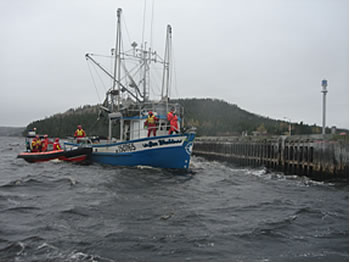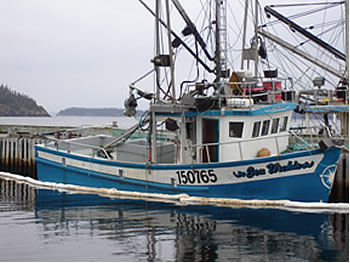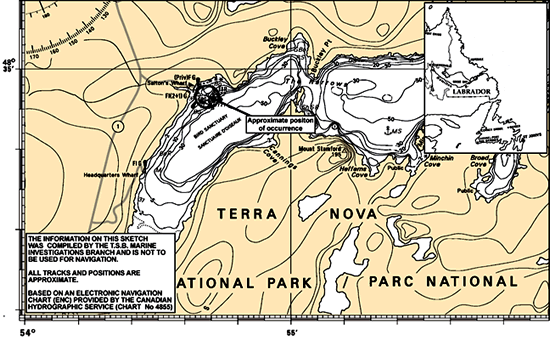Capsizing and Loss of Life
Small fishing vessel Sea Urchin
Newman Sound, Newfoundland and Labrador
The Transportation Safety Board of Canada (TSB) investigated this occurrence for the purpose of advancing transportation safety. It is not the function of the Board to assign fault or determine civil or criminal liability. This report is not created for use in the context of legal, disciplinary or other proceedings. See Ownership and use of content. Masculine pronouns and position titles may be used to signify all genders to comply with the Canadian Transportation Accident Investigation and Safety Board Act (S.C. 1989, c. 3).
Summary
On 04 November 2007, the small fishing vessel Sea Urchin was taking part in a Canadian Coast Guard training exercise in Newman Sound. At approximately 1440 Newfoundland standard time, following completion of the exercise, the vessel capsized while proceeding to the wharf. All three persons on board were rescued, but one person later succumbed in hospital.
Factual information
Particulars of the vessel
| Name | Sea Urchin |
|---|---|
| Licence number | C02807NF |
| Home port | Charlottetown, Newfoundland and Labrador |
| Type | Small fishing vessel |
| Gross tonnage | Not assigned - not exceeding 15 |
| LengthFootnote 1 | 10.64 m |
| Draught | 1.32 m |
| Built | 2000, Jackson's Boatyard, Whiteway, Newfoundland and Labrador |
| Propulsion | 157 kW, marine diesel engine |
| Crew | 2 |
| Registered owners | Private owners, Charlottetown, Newfoundland and Labrador |
Description of the vessel
The Sea Urchin is a small fishing vessel of closed construction, with a fibreglass-over-wood hull and a transom stern. The hull below the main deck is subdivided by three transverse watertight bulkheads that enclose, from forward, the crew accommodation space, the engine room, a fish hold, and a lazarette in which the hydraulic steering gear is located.
The vessel is powered by a marine diesel engine with a reverse/reduction gearbox driving a single fixed-pitch propeller and is fitted with a single plate centreline rudder. A total of four built-in diesel tanks are arranged on the port and starboard sides of the engine room and the lazarette.
Access to the engine room is through the superstructure, which also encloses the wheelhouse, dining area, and a diesel stove. On the starboard side of the wheelhouse are the conning position and a weathertight Dutch door opening onto the starboard side deck of the vessel. On the port side, a weathertight door facing aft allows access to the working deck.
History of the voyage
On 03 November 2007, the ownersFootnote 2 of the Sea Urchin were contacted by the Canadian Coast Guard (CCG) to assist in fast rescue craft (FRC) training.Footnote 3 That afternoon, the Sea Urchin, with two of the three owners acting as operator and crew, respectively, arrived in Salton's Brook, Newfoundland and Labrador (N.L.). A CCG instructor joined the vessel early on 04 November 2007. The vessel—with a total of three persons on board—then departed for Newman Sound, N.L., accompanied by two FRC, each with a crew of four CCG personnel.
Following completion of the training, the two FRC proceeded to the wharf, followed by the slower Sea Urchin. Approximately 100 m from the wharf, with wind and waves striking its port quarter, the Sea Urchin heeled about 20° to starboard before righting itself. At about 1440,Footnote 4 waves and a strong wind gust caused the vessel to again heel to starboard. Water came through the freeing ports and over the gunwale, and a seine net, which was stowed unsecured on the after deck, slid toward the starboard side. Water then entered the wheelhouse through the doors, which had been secured open, and the vessel capsized.
The CCG instructor had been standing just outside the port door as the vessel capsized. The operator and the crew member exited the wheelhouse as it flooded. The crew member and CCG instructor, who were in the water, disentangled themselves from ropes, net, and floating debris, and assisted the operator. The CCG lead instructor wore an anti-exposure suit. Neither the operator nor the crew member wore any type of personal flotation device (PFD).
The FRC were being secured on the opposite side of the wharf with an obstructed view of the accident site. Subsequently, a CCG trainee noticed that the Sea Urchin had capsized. Both FRC returned to the Sea Urchin, arriving on scene in about one minute. The three people, who had been in the water between 10 and 15 minutes, were recovered and transported to the wharf.
CCG rescue specialists taking part in the training rendered emergency assistance to the operator, who had a reduced level of consciousness. Once at the wharf, ambulances arrived within 15 minutes. The operator, accompanied by the crew member, was taken to hospital in Gander, N.L. The operator was later transferred to the St. John's Health Sciences Centre, N.L., where he later succumbed.
Crew certification and experience
The operator held a Pleasure Craft Operator Card issued by the Canadian Coast Guard Auxiliary (CCGA), a marine emergency duties (MED) level A3 certificate, a radio operator certificate (ROC-MC), and a marine advanced first aid certificate. He had over 40 years' experience on fishing vessels. He did not have other formal navigation training or certification, nor were any required.
The crew member had over 15 years' experience on fishing vessels and held a fishing master, fourth class certificate of competency, issued on 19 April 2006. Because the Sea Urchin did not exceed 15 in gross tonnage, no such certification or training was required at the time of the occurrence.Footnote 5
Vessel certification and stability
As a small fishing vessel not exceeding 15 in gross tonnage, the Sea Urchin was subject to Part II of the Small Fishing Vessel Inspection Regulations (SFVIR). The vessel was not required to submit any stability data for approval, it did not require any inspection by Transport Canada, nor had such an inspection been performed.
No stability assessment was required by the CCG to operate as a CCGA vessel; however, the vessel had received and successfully passed a Courtesy Examination for Small Fishing Vessels under 15 GRTFootnote 6 by the CCG in 2002, 2004, and 2006.
No lines plan was available for the Sea Urchin; however, after the occurrence, the underwriter had the vessel taken out of the water at which time he determined the hull shape data, which were used to prepare a computerized model of the hull. The underwriter also carried out a post-occurrence inclining experiment to establish the vessel's lightship characteristics.
Using this information, as well as estimates of the weights on board at the time, the TSB later conducted a post-occurrence stability analysis.Footnote 7 Various conditions were prepared to reflect the lightly loaded vessel during the prevailing weather. Vessel stability was then assessed and compared against the STAB 4 stability standards.Footnote 8
The first simulation was carried out with no wind or waves. In this condition, the vessel's metacentric height (GM) exceeded the corresponding stability criterion, but the reserve stability was deficient at large angles.Footnote 9
A second simulation used the same weights, but factored in a 30-knot wind (without waves) on the port side. The results showed a slight improvement. The wind reduced the initial list caused by the seine net to less than 1° on the starboard side; however, the reserve stability remained deficient.
Finally, a set of simulations featured the waves acting on the port quarter, with the wave crests passing under and along the vessel's hull. The results showed transitory and occasionally marked reductions and variations in stability, depending on the location of the wave crest. The reserve stability was again deficient compared to almost all the stability criteria, regardless of the location, and the area under the righting arm (GZ) curve was reduced to minimal. The angle of heel at equilibrium varied largely from one side to the other, which meant that the vessel rolling was exacerbated.
Weather
Conditions in Newman Sound at the time of the occurrence were estimated to be south-southwest winds gusting to approximately 35 knots, 1 m seas, and overcast with light rain.
Analysis
Stability at the time of capsizing
The TSB's post-occurrence stability analysis revealed that, during the voyage, the lightly loaded vessel's reserve of transverse stability did not meet the minimum criteria of STAB 4. The deficient stability was further affected by the dynamic effects of the quartering seas. Regulatory stability criteria are based on static water surfaces. In practice, however, the distribution of buoyant support varies as wave crests pass under or along a vessel's hull, causing transitory and occasionally marked reductions in stability.
In this occurrence, the effects of the wind gusts and quartering seas, combined with the already deficient stability, caused the vessel to roll until it exceeded the angle of vanishing stability and capsized.
The stability analysis also noted that, by the time water began entering through the open doors, the vessel had already exceeded the angle of vanishing stability. Similarly, the shifting of the seine net, which was observed sliding toward the starboard side just before the capsizing, only accelerated the rate of capsizing. Neither event was considered causal. Nonetheless, there exists the risk that, in other instances, open doors could cause downflooding and the shifting of unsecured gear could be detrimental to a vessel's stability.
Requirement for stability data
There is no requirement for small uninspected fishing vessels, such as the Sea Urchin, to submit stability data to Transport Canada for information, review, or approval. Although Transport Canada is reviewing this requirement under the proposed Fishing Vessel Safety Regulations pursuant to the Canada Shipping Act, 2001, these proposed regulations are not expected to be published in Canada Gazette, Part I, before autumn 2009.
The Board has repeatedly expressed the concern that the stability characteristics of most small fishing vessels are not formally assessed and, consequently, that their safe operation is compromised when vessels that have inadequate stability characteristics continue to be in service. In November 2003, following the loss of the fishing vessel Cap Rouge II,Footnote 10 the Board issued two recommendations to Transport Canada (M03-05 and M03-06), calling for the assessment/verification of stability for new and existing small inspected fishing vessels. In 2005, following the loss of the small fishing vessel Ryan's CommanderFootnote 11 and concerned that, in the absence of meaningful action to address previous recommendations, fishers continued to be placed at undue risk, the Board issued another recommendation (M05-04) calling on Transport Canada to immediately implement recommendations M03-05 and M03-06.
In response, Transport Canada established an interim policy for determining, based on a list of risk factors, whether a small inspected fishing vessel requires a stability booklet.Footnote 12 Transport Canada also issued Ship Safety Bulletin 04/2006, Safety of Small Fishing Vessels: Information to Owners/Masters about Stability Booklets. The bulletin, which applies to fishing vessels between 15 and 150 in gross tonnage and not more than 24.4 m in length, outlines the process that vessel owners and operators must follow to determine if their vessel requires a stability booklet and how to obtain one.
In 2008, the TSB reassessed Transport Canada's responses to Board Recommendations M03-05, M03-06, and M05-04. Although the responses to each were found to be fully satisfactory, it was noted that TSB marine staff will continue to monitor the implementation of interim measures before the coming into force of the new Fishing Vessel Safety Regulations.
While recommendations M03-05 and M03-06 were made in relation to small inspected fishing vessels (with a gross tonnage over 15 but not over 150), the principles also apply to small uninspected fishing vessels (not exceeding 15 in gross tonnage) given that the risk associated with their operation is similarly high.
In this regard, Transport Canada mailed Ship Safety Bulletin 04/2006 to owners of fishing vessels of 15 gross tons or less. Recipients were encouraged to determine if a stability booklet would be beneficial in operating their vessels safely.
Therefore, without a formal assessment of the stability characteristics of small fishing vessels, their safe operation may be compromised and fishers may continue to be placed at undue risk.
Crew knowledge and training
The operator had over 40 years' experience on fishing vessels. However, he had no formal training in vessel stability. The crew member held a fishing master, fourth class certificate issued on 19 April 2006. The syllabus has subsequently been improved with respect to stability.
Generally, few fishers fully understand the principles of ship stability. As a result, occurrences such as this continue to happen. To mitigate this, stability education and evaluation coursesFootnote 13 would raise fishers' awareness of the cumulative nature of the factors that can compromise vessel stability.
Formal training and experience can provide an enhanced awareness of safe practices during normal and emergency operations. Previous occurrences have shown that adequate knowledge of vessel stability is critical to the safe operation of fishing vessels. Lack of this knowledge or ability has been shown to have played a role in several recent capsizings and sinkings.Footnote 14
Consequently, crews that are unaware of the stability characteristics of their vessel, and the general principles involved, may unknowingly place themselves and their vessels at undue risk.
Findings
Finding as to causes and contributing factors
- The effects of the wind gusts and quartering seas, combined with the already deficient stability, caused the vessel to roll until it exceeded the angle of vanishing stability and capsized.
Findings as to risk
- Crews that are unaware of the stability characteristics of their vessel, and the general principles involved, may unknowingly place themselves and their vessels at undue risk.
- The detrimental effects of not securely stowing gear and ensuring that weathertight openings are properly closed compromise the overall crew and vessel safety.
- Without a formal assessment of the stability characteristics of small fishing vessels, their safe operation may be compromised and operators may continue to be placed at undue risk when operating vessels with inadequate stability characteristics.
This report concludes the Transportation Safety Board's investigation into this occurrence. Consequently, the Board authorized the release of this report on .


